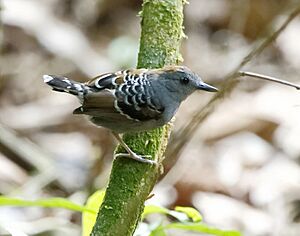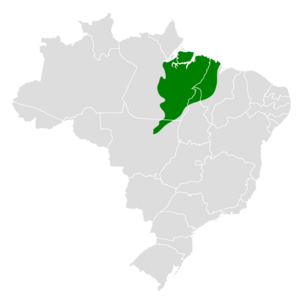Xingu scale-backed antbird facts for kids
Quick facts for kids Xingu scale-backed antbird |
|
|---|---|
 |
|
| Conservation status | |
| Scientific classification | |
| Genus: |
Willisornis
|
| Species: |
vidua
|
 |
|
| Range of W. v. vidua (see taxonomy and distribution sections) | |
| Synonyms | |
|
|
The Xingu scale-backed antbird (Willisornis vidua) is a small bird found only in Brazil. It belongs to a family of birds called "typical antbirds". These birds often follow swarms of army ants to find food.
Contents
About Its Name
For a long time, the Xingu scale-backed antbird was thought to be a type of another bird. That bird was called the scale-backed antbird. When scientists realized it was a separate species, they gave it its own name. The other bird was then called the common scale-backed antbird.
This bird's scientific name has changed many times. It was once placed in different groups, like Hypocnemis and Hylophylax. Now, it is in the group Willisornis. A German bird expert, Jean Cabanis, first described it in 1847. Its English name comes from the Xingu River in Brazil.
Scientists still discuss how to classify this bird. Most groups, like the International Ornithological Committee, say it has two types, called subspecies. These are W. v. vidua and W. v. nigrigula. However, another group, BirdLife International, thinks these two types are actually separate species. They call them the Xingu and Tapajos scale-backed antbirds. This article follows the idea that it is one species with two subspecies.
What Does It Look Like?
The Xingu scale-backed antbird is about 12 to 13 cm (4.7 to 5.1 in) long. That's about the length of a small pencil. It weighs between 14 to 19.5 g (0.49 to 0.69 oz).
Adult males of the main subspecies are mostly gray. Their upper parts are darker than their belly. They have a white patch on their back, between their wings. Their lower back has black patches with white edges. These patches look like scales, which gives the bird its name. Their wings and tail are black with white edges and tips.
Adult females have a warm brown top of the head and a gray face. Their upper body is warm brown, and their belly is gray. Their throat is white. Both males and females have grayish eyes, a black beak, and pale gray legs and feet.
Males of the subspecies W. v. nigrigula have a black throat. Their upper parts are a bit darker than the main subspecies. Females of nigrigula have a larger white patch on their back. Otherwise, they look the same as the main subspecies' females.
Where Does It Live?
The Xingu scale-backed antbird lives in south-central and eastern Amazonian Brazil. You can find it south of the Amazon River.
The main subspecies, W. v. vidua, lives between the Rio Xingu and western Maranhão state. It also goes south into northern Tocantins state. The subspecies W. v. nigrigula lives further west. It is found between the Tapajós and Xingu rivers. It also goes south into northern Mato Grosso state.
This bird mostly lives in the lower parts of humid, evergreen forests. These are called terra firme forests. It can also be found in várzea forests, which are floodplains. It lives from sea level up to about 800 m (2,600 ft) high.
How It Moves Around
The Xingu scale-backed antbird is thought to stay in the same area all year. It does not migrate.
What It Eats
This bird mainly eats many different kinds of arthropods, like insects and spiders. It usually looks for food alone, in pairs, or in family groups. It often forages about 1 m (3 ft) off the ground. Sometimes it goes as high as 3 m (10 ft), and rarely up to 5 m (16 ft).
It sometimes follows groups of army ants. These ants move through the forest and scare other small creatures. The antbird then catches the prey trying to escape the ants. But it also finds food away from ant swarms. It catches prey by flying a short distance from a branch to the ground. It also catches prey from leaves, branches, and vines. Sometimes, it stays on the ground, poking around and flipping over dead leaves.
Reproduction and Nests
Scientists do not know much about the Xingu scale-backed antbird's breeding season. Only a few nests have been found. They were shaped like cups and made of dried leaves and plant fibers. Two nests were found in holes on top of old, rotten tree stumps. Another nest was on the ground, hidden in leaf litter at the bottom of a palm tree.
Only one clutch of eggs is known. It had two eggs. They were a pinkish-violet color with dark streaks and blotches. Only the female was seen sitting on the eggs. However, scientists think both parents help incubate the eggs, like other antbirds. How long the eggs take to hatch and when the young birds leave the nest are not yet known.
Its Calls and Songs
The Xingu scale-backed antbird's song is a series of long, rising notes. These notes change in pitch in a smooth pattern. Its calls include a "twitter" sound. This is a short, high-pitched series of clear, musical notes that go down slightly in pitch. It also makes a "chirr" sound that goes down in pitch. Another call is a rough series of 3–4 "cheery, cheery, churry, churry" notes.
How Many Are Left?
The IUCN (International Union for Conservation of Nature) looks at the two subspecies separately. Both are considered to be of "Least Concern". This means they are not in immediate danger of disappearing. Both subspecies live in a large area. Their total population size is unknown, but it is believed to be stable. No immediate threats to either subspecies have been found.
The Xingu scale-backed antbird is thought to be quite common in the areas where it lives. Its home includes several large protected areas. However, the eastern parts of its range have lost many trees. This is due to a lot of ongoing deforestation and breaking up of forests in recent years.


